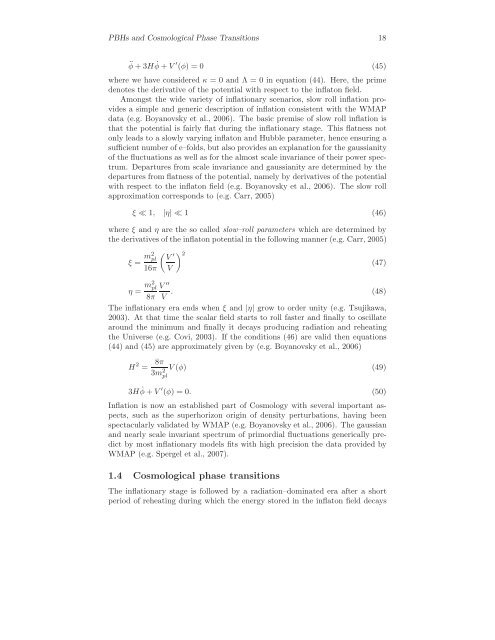Primordial Black Holes and Cosmological Phase Transitions Report ...
Primordial Black Holes and Cosmological Phase Transitions Report ...
Primordial Black Holes and Cosmological Phase Transitions Report ...
You also want an ePaper? Increase the reach of your titles
YUMPU automatically turns print PDFs into web optimized ePapers that Google loves.
PBHs <strong>and</strong> <strong>Cosmological</strong> <strong>Phase</strong> <strong>Transitions</strong> 18<br />
¨φ +3H ˙ φ + V ′ (φ) = 0 (45)<br />
where we have considered κ = 0 <strong>and</strong> Λ = 0 in equation (44). Here, the prime<br />
denotes the derivative of the potential with respect to the inflaton field.<br />
Amongst the wide variety of inflationary scenarios, slow roll inflation provides<br />
a simple <strong>and</strong> generic description of inflation consistent with the WMAP<br />
data (e.g. Boyanovsky et al., 2006). The basic premise of slow roll inflation is<br />
that the potential is fairly flat during the inflationary stage. This flatness not<br />
only leads to a slowly varying inflaton <strong>and</strong> Hubble parameter, hence ensuring a<br />
sufficient number of e–folds, but also provides an explanation for the gaussianity<br />
of the fluctuations as well as for the almost scale invariance of their power spectrum.<br />
Departures from scale invariance <strong>and</strong> gaussianity are determined by the<br />
departures from flatness of the potential, namely by derivatives of the potential<br />
with respect to the inflaton field (e.g. Boyanovsky et al., 2006). The slow roll<br />
approximation corresponds to (e.g. Carr, 2005)<br />
ξ ≪ 1, |η| ≪ 1 (46)<br />
where ξ <strong>and</strong> η are the so called slow–roll parameters which are determined by<br />
the derivatives of the inflaton potential in the following manner (e.g. Carr, 2005)<br />
ξ = m2 pl<br />
16π<br />
V ′<br />
V<br />
2<br />
(47)<br />
η = m2pl V<br />
8π<br />
′′<br />
. (48)<br />
V<br />
The inflationary era ends when ξ <strong>and</strong> |η| grow to order unity (e.g. Tsujikawa,<br />
2003). At that time the scalar field starts to roll faster <strong>and</strong> finally to oscillate<br />
around the minimum <strong>and</strong> finally it decays producing radiation <strong>and</strong> reheating<br />
the Universe (e.g. Covi, 2003). If the conditions (46) are valid then equations<br />
(44) <strong>and</strong> (45) are approximately given by (e.g. Boyanovsky et al., 2006)<br />
H 2 = 8π<br />
3m2 V (φ) (49)<br />
pl<br />
3H ˙ φ + V ′ (φ) = 0. (50)<br />
Inflation is now an established part of Cosmology with several important aspects,<br />
such as the superhorizon origin of density perturbations, having been<br />
spectacularly validated by WMAP (e.g. Boyanovsky et al., 2006). The gaussian<br />
<strong>and</strong> nearly scale invariant spectrum of primordial fluctuations generically predict<br />
by most inflationary models fits with high precision the data provided by<br />
WMAP (e.g. Spergel et al., 2007).<br />
1.4 <strong>Cosmological</strong> phase transitions<br />
The inflationary stage is followed by a radiation–dominated era after a short<br />
period of reheating during which the energy stored in the inflaton field decays
















